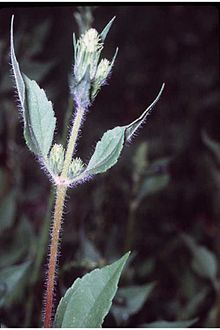- Iva annua
-
Iva annua 
Scientific classification Kingdom: Plantae (unranked): Angiosperms (unranked): Eudicots (unranked): Asterids Order: Asterales Family: Asteraceae Genus: Iva Species: I. annua Binomial name Iva annua
L.Iva annua, sumpweed or marshelder, is an herbaceous annual plant native to much of North America.
Uses
Iva annua var. macrocarpa was formerly cultivated by Native Americans in the central eastern United States and specifically the indigenous peoples of the Kansas City Hopewell culture in present day Missouri and Illinois, for its edible seed. As the author Jared Diamond notes, the edible parts contain 32 percent protein and 45 percent oil.
However, like its relative ragweed, Diamond notes that sumpweed possesses many objectionable qualities which include being a severe allergen, possessing "a strong odor objectionable to some people and that handling it can cause skin irritation." For these reasons Diamond believes that it was abandoned once more pleasant alternatives (like corn) were available, and by the time Europeans arrived in the Americas had long disappeared as a crop.[1]
Notes
- ^ Jared Diamond (2003). Guns, Germs and Steel. New York: Norton. p. 151.
External links
- "Iva annua L.". MissouriPlants.com. http://www.missouriplants.com/Greenopp/Iva_annua_page.html. Includes photographs.
Categories:- Asteraceae
- Grains
- Flora of the Plains-Midwest (United States)
- Flora of the Great Lakes region (North America)
- Flora of Missouri
- Flora of Illinois
- Flora of Michigan
- Edible nuts and seeds
- Native American cuisine
- Crops originating from the United States
- Agriculture stubs
Wikimedia Foundation. 2010.
